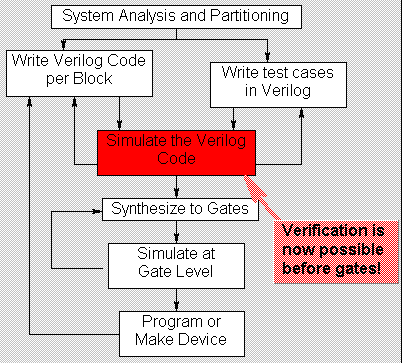The diagram below summarizes the high level design flow for an ASIC (ie. gate array, standard cell) or FPGA. In a practical design situation, each step described in the following sections may be split into several smaller steps, and parts of the design flow will be iterated as errors are uncovered.
System-level Verification
As a first step, Verilog may be used to model and
simulate aspects of the complete system containing one or more
ASICs. This may be a fully functional description of the system
allowing the ASIC specification to be validated prior to
commencing detailed design. Alternatively, this may be a partial
description that abstracts certain properties of the system, such
as a performance model to detect system performance bottle-necks.
RTL design and testbench creation
Once the overall system architecture and partitioning is
stable, the detailed design of each ASIC can commence. This
starts by capturing the ASIC design in Verilog at the register
transfer level, and capturing a set of test cases in Verilog.
These two tasks are complementary, and are sometimes performed by
different design teams in isolation to ensure that the
specification is correctly interpreted. The RTL Verilog should be
synthesizable if automatic logic synthesis is to be used. Test
case generation is a major task that requires a disciplined
approach and much engineering ingenuity: the quality of the final
ASIC depends on the coverage of these test cases.
RTL verification
The RTL Verilog is then simulated to validate the
functionality against the specification. RTL simulation is
usually one or two orders of magnitude faster than gate level
simulation, and experience has shown that this speed-up is best
exploited by doing more simulation, not spending less time on
simulation.
In practice it is common to spend 70-80% of the ASIC design cycle writing and simulating Verilog at and above the register transfer level, and 20-30% of the time synthesizing and verifying the gates.
Look-ahead Synthesis
Although some exploratory synthesis will be done early
on in the design process, to provide accurate speed and area data
to aid in the evaluation of architectural decisions and to check
the engineer's understanding of how the Verilog will be
synthesized, the main synthesis production run is deferred until
functional simulation is complete. It is pointless to invest a
lot of time and effort in synthesis until the functionality of
the design is validated.
70% of design time at RTL!

![]() Verilog
FAQ
Verilog
FAQ
![]() Doulos Training Courses
Doulos Training Courses
![]() Return to
Hardware Designer’s Guide Contents
Return to
Hardware Designer’s Guide Contents
Copyright 1995-1996 Doulos
This page was last updated 15th November 1996.
![]() We welcome your e-mail comments. Please contact us at: webmaster@doulos.co.uk
We welcome your e-mail comments. Please contact us at: webmaster@doulos.co.uk